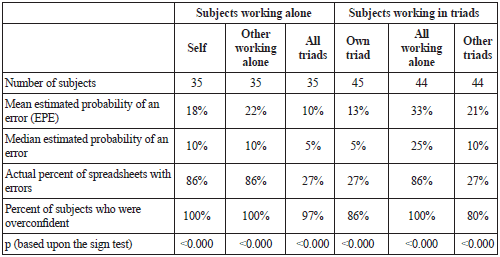Authors
Raymond R. Panko
Abstract
This chapter describes two experiments that examined overconfidence in spreadsheet development. Overconfidence has been seen widely in spreadsheet development and could account for the rarity of testing by end-user spreadsheet developers.
The first experiment studied a new way of measuring overconfidence. It demonstrated that overconfidence really is strong among spreadsheet developers.
The second experiment attempted to reduce overconfidence by telling subjects in the treatment group the percentage of students who made errors on the task in the past. This warning did reduce overconfidence, and it reduced errors somewhat, although not enough to make spreadsheet development safe.
Sample

Subjects were highly overconfident when estimating their error rates.
Subjects working alone thought, on average, that there was only an 18% probability that they would make an error. In fact, 86% of them made errors.
For triads, the average expected probability of error for their own group's spreadsheet was "only" about 50% too low — 13% instead of 27%.
Publication
2009, Book chapter, Evolutionary concepts in end user productivity and performance: Applications for organizational progress, Chapter IX, pages 131-149
Full article
Two experiments in reducing overconfidence in spreadsheet development
